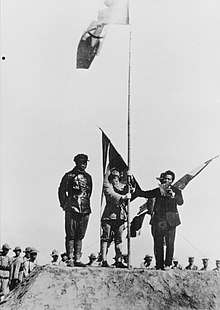Guominjun
The Guominjun (simplified Chinese: 国民军; traditional Chinese: 國民軍; pinyin: Guómínjūn; Wade–Giles: Kuominchün), a.k.a. Nationalist Army, KMC, also called the Northwest Army (西北軍) or People's Army, refers to the military faction founded by Feng Yuxiang, Hu Jingyi and Sun Yue during China's Warlord Era. It was formed when Feng betrayed the Zhili clique during the Second Zhili–Fengtian War with the Fengtian clique in 1924. The Guominjun occupied Beijing, captured Zhili leader Cao Kun and expelled former Qing dynasty emperor Puyi from the Forbidden City.

| Guominjun | |
|---|---|
| Participant in the Warlord Era | |
| Ideology | Chinese nationalism[1] Anti-imperialism[2] Christian socialism Three Principles of the People (partially)[3] Christianity with Chinese characteristics[4] Pro-Sovietism |
| Leaders | Feng Yuxiang Hu Jingyi Sun Yue |
| Area of operations | Northern Republic of China |
| Battles and war(s) | Beijing Coup Anti-Fengtian War Northern Expedition |
The Guominjun was very sympathetic to Sun Yat-sen's Kuomintang regime in Guangzhou, but due to geographic isolation they were independent of one another. The Guominjun was unusual for being an ideological army with its troops indoctrinated in Christian, socialist, and nationalist teachings. It also cared for its troops with welfare and education programs which was very rare at the time. This created a very determined, cohesive fighting force with high morale. One of its weaknesses was its small size and large territorial coverage, which meant that its troops were spread thinly.
The Guominjun's main foreign backer was the Soviet Union which had vied with the Japanese Empire for influence over the Fengtian clique. The Soviets were keen on building a relationship with Feng as he was seen as more ideologically acceptable.
In late 1925, Fengtian general Guo Songling defected to the KMC; this sparked the Anti-Fengtian War against Zhang Zuolin. The Guominjun was on the losing side until the KMT launched its Northern Expedition. It merged with the Kuomintang's National Revolutionary Army to defeat the Fengtian forces. In 1929, Feng grew increasingly dissatisfied with Chiang Kai-shek's regime; the Guominjun launched a full rebellion, the Central Plains War, in 1930. However, Feng was defeated and what was left of the faction was absorbed into the KMT.
References
- Sheridan (1966), pp. 169–174.
- Sheridan (1966), pp. 172–174, 176.
- Sheridan (1966), pp. 170–172.
- Sheridan (1966), pp. 174–176.
Bibliography
- Sheridan, James E. (1966). Chinese Warlord. The Career of Feng Yü-hsiang. Stanford, California: Stanford University Press.CS1 maint: ref=harv (link)